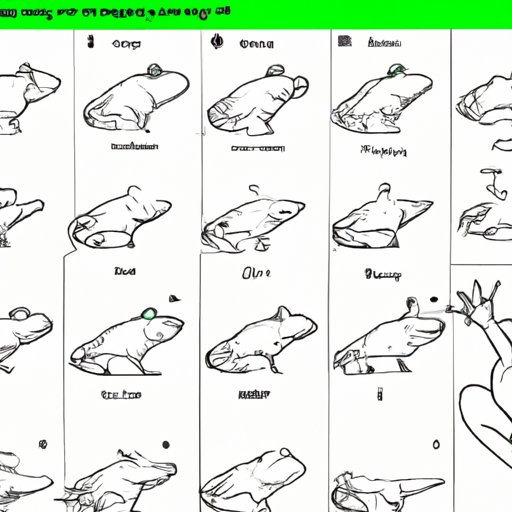
Introduction
Drawing is an incredibly rewarding creative outlet for people of all ages. However, it can often be intimidating for beginners, especially when trying to tackle complex subjects like animals. In this article, we will provide a step-by-step guide on how to draw an easy frog, broken down into simple shapes and lines, along with tips, exercises, and fun prompts to help enhance your drawing skills.
Step-by-Step Guide
Before starting, it’s important to remember to begin with simple shapes and lines. Starting with basic shapes ensures that the outline remains in proportion and helps to build confidence.
To begin, start with a large oval shape for the frog’s body and a smaller oval shape connected on the upper end for the head. Next, add two half-circles on each side of the head for the eyes, followed by two smaller circles inside the half-circles for the pupils.
Finally, connect the body with four simple leg shapes, and add a smile or a tongue for a bit of personality. Use a pen or marker to go over the final lines, and use shading or color to give your frog some depth.
Here is a step-by-step guide:

The Frog’s Anatomy
While the basic frog shape can be created with simple shapes, understanding the anatomy of a frog can help to make the drawing more accurate. A frog has a long, slender body with longer back legs and shorter front legs. The eyes sit on either side of the head, and the mouth and nostrils are located at the base of the head. Knowing this can make the drawing more lifelike and the proportions more accurate.
Here are some tips for enhancing your frog drawing:
- Draw the back legs longer than the front legs.
- The eyes should be large and placed on either side of the head.
- Use curves to accentuate the slender body.
Fun Facts
Before we dive into the next drawing exercises, let’s take a look at some fun facts about frogs:
- Frogs are amphibians, meaning they can both live on land and in water.
- Frogs absorb water through their skin, which can make them an excellent environmental indicator species.
- Some types of frogs can jump over 20 times their body length in one leap.
Now that we know a bit more about frogs, let’s have some fun and try drawing a frog in a unique way, such as a frog skipping rope or reading a book. Here is a step-by-step guide with accompanying images:

Drawing Exercises
Developing any skill takes practice, so for those who want to improve their drawing skills, here are a few suggested exercises:
- Practice drawing basic shapes such as circles, triangles, squares, and rectangles. This will help when creating more complicated drawings.
- Practice drawing lines in different directions and at varying lengths.
- Practice shading by creating different tones and gradients.
Now, let’s apply these drawing exercises to improve our frog drawing abilities. Here is a step-by-step guide with accompanying images:

Creative Prompts
Feeling unoriginal or stuck in a rut with your drawings? Creative prompts are an excellent way to push yourself out of your comfort zone and try something new. Here are some prompts for drawing frogs in unique contexts:
- A frog at a carnival.
- A frog on a hot-air balloon.
- A frog during a superhero mission.
Here are some accompanying images:

Turning to Nature
One of the best ways to improve your drawing is to turn to nature for inspiration. Observe frogs in their natural habitat and try to draw the shapes and basic constructions that you see. Incorporating nature into your drawings can create a more realistic and organic feel. Here are some images of frogs in their natural habitats:

Easy Alternatives
For those who want to take the easy route, mock-up and templates offer a great alternative. These types of templates include pre-made shapes to create a basic frog drawing. Customize the drawing to your liking, and you have a simple frog drawing with minimal effort. Here are some mock-up and template images:

Conclusion
Drawing can be intimidating for beginners, but as we have shown here, by starting with basic shapes and lines, you can create a lifelike frog drawing with some simple techniques and exercises.





